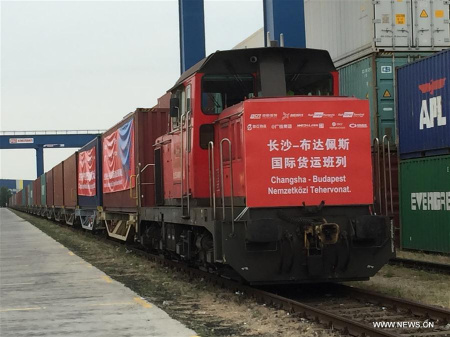
A new freight train arrives at the Budapest Intermodal Logistic Center in Budapest, Hungary, on June 16, 2017. This freight train departed from southern Chinese city of Changsha on May 27, carrying 41 containers of electronic products, shoes and apparel, fiber optic cable, hardware and machinery parts made in China. (Xinhua/Yang Yongqian)
In 1601, an Italian missionary named Matteo Ricci (1552-1610) entered the Forbidden City in Beijing, the Chinese imperial palace, opening a path for East-West cultural exchange that many people set foot on.
Inspired by Matteo Ricci's legend, in 1986, Dionisio Cimarelli, aged 21 then, boarded a Trans-Siberian train to Beijing for the first time.
FASCINATED WITH CHINA
"China is one of my very old passion. Since I was a student, I was very interested in Chinese culture, Chinese art, Chinese people....so in 1986 I stopped my study in the academy and I decided to move to China for a big trip," said Cimarelli, who now teaches sculpture at the New York Academy of Arts.
"Matteo Ricci probably went to China to teach, but I went there primarily to understand, which was also my way to try to understand and exchange, and explain to the Chinese my culture, my education, and Chinese can teach me their own culture," he told Xinhua.
China at that time was not yet fully open to tourism and streets of its cities were full of bikes, no busy traffic at all, he recalled.
"...in 1986, I found China a poor country, it was coming out from a very difficult time in terms of economy and culture. But in 1986 I was also able to see the beginning of the change after the opening-up," he said, referring to China's adoption of the policy of reform and opening to the outside world in 1978.
Cimarelli returned to find a very different China in 2004 and he stayed nine years since in the booming country.
"I feel very lucky and I'm very very proud that I was able to see this change which would not only be part of China, but also part of the world change," he said.
"I saw huge change. From 1986 to 2004, China already changed a lot," he said.
"But during my nine years in China from 2004 to 2013, there was huge, enormous, amazing change. I was able to see every week the difference in Shanghai and Beijing, which I was going to very often. Continuously I saw the change," he said.
"I would say that in 2007 and 2008, there were the biggest changes in Beijing before the Olympic Games, I would say the change was 180 degree completely," he said.
"I could also see the change of people, the change of the attitude of the Chinese. They became more wealthy, they started to travel, they started to know. For the young people, they were able to do their Ph.D. in Europe and the U.S.A. So there are the enormous changes, you almost can't recognize the country, I would say," he said.


















































